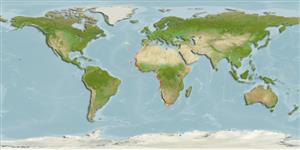Common names from other countries
Classification / Names / Names
Populärnamn | synonymer | Catalog of Fishes (gen., sp.) | ITIS | CoL | WoRMS
Environment: milieu / climate zone / depth range / distribution range
Ekologi
; djupintervall 12 - 400 m (Ref. 435), usually 50 - 150 m (Ref. 435). Tropical
Eastern Atlantic: West Africa from Sahara to Angola.
Length at first maturity / Size / Vikt / Age
Maturity: Lm ? range ? - ? cm Max length : 7.6 cm CL hane/ej könsbestämd; (Ref. 435)
Maximum carapace width: 9.6 cm. Burrows in mud or sandy mud at depths of 12 to 400m, common at depths of 50 to 150 m (Ref. 435).
Life cycle and mating behavior
Könsmognad | Reproduktion | Lek | Ägg | Fecundity | Larver
Members of the order Decapoda are mostly gonochoric. Mating behavior: Precopulatory courtship ritual is common (through olfactory and tactile cues); usually indirect sperm transfer.
Fischer, W., G. Bianchi and W.B. Scott (eds.). 1981. (Ref. 435)
IUCN Red List Status (Ref. 130435)
CITES status (Ref. 108899)
Not Evaluated
Not Evaluated
Threat to humans
Harmless
Human uses
Fiskeri: av potentiellt intresse
| FishSource |
Verktyg
Ytterligare information
Age/SizeTillväxtLength-weightLength-lengthMorfologiLarverAbundans
Internet-källor
Estimates based on models
Preferred temperature
(Ref.
115969): 14.2 - 20.5, mean 16.7 (based on 50 cells).
Vulnerability
Low vulnerability (10 of 100).
Price category
Unknown.
